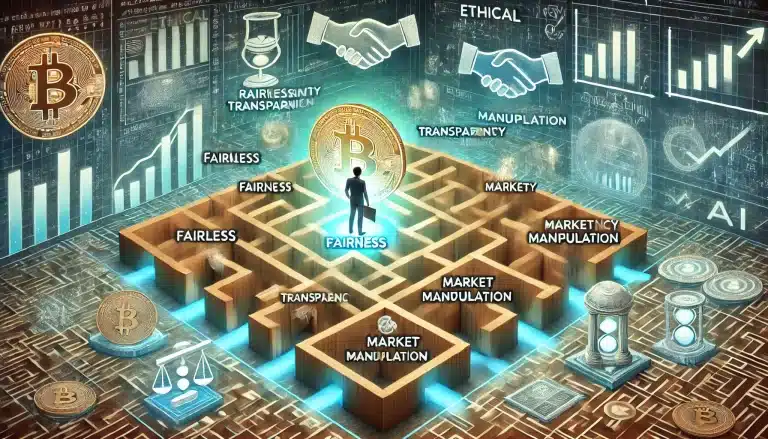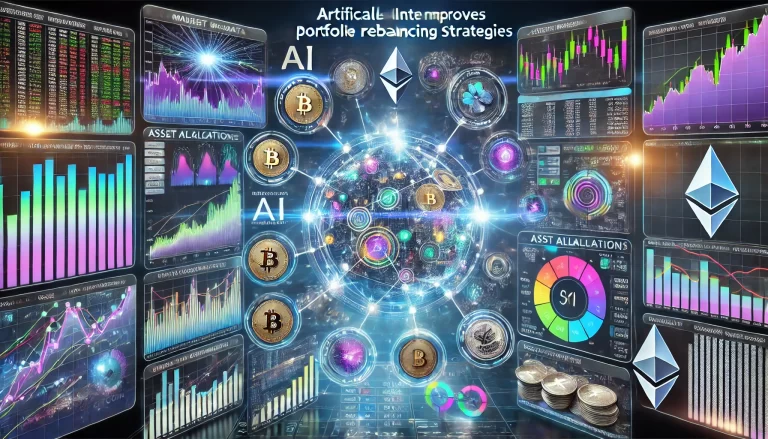Did you know that 70% of successful crypto traders now use machine learning algorithms to gain an edge in the market?
Welcome to the cutting-edge world of AI-powered cryptocurrency trading! In this article, we’ll dive into the top 5 machine learning algorithms that are transforming the way traders navigate the volatile crypto seas.
From predicting price movements to optimizing trading strategies, these algorithms are the secret weapons of today’s most successful crypto traders. Ready to supercharge your trading game? Let’s get started!
1. Long Short-Term Memory (LSTM) Networks

Let me tell you, when I first heard about Long Short-Term Memory networks, I thought it was some kind of joke. Like, how can something be both long and short-term? Turns out, it’s no laughing matter – these babies are the real deal when it comes to predicting crypto prices.
I remember the first time I tried to use an LSTM for my crypto trading. Boy, was that a disaster! I had no clue what I was doing, just throwing data at it like I was feeding ducks at the park. Spoiler alert: neural networks aren’t ducks, and they don’t like being force-fed random numbers.
But here’s the thing about LSTMs – they’re like that friend who never forgets anything. You know the type, right? The one who remembers what you wore to your cousin’s wedding three years ago? That’s an LSTM for ya. They’re crazy good at remembering important stuff from way back and using it to make predictions about the future.
In the world of crypto, that’s a superpower. Think about it – Bitcoin’s price today might be influenced by something that happened months ago. A regular old algorithm might forget about that, but an LSTM? It’s got that info locked down tight.
I’ve learned (the hard way) that LSTMs are particularly awesome for time series prediction. That’s just a fancy way of saying they can look at how crypto prices have changed over time and make some pretty solid guesses about where they’re headed next. It’s like having a crystal ball, except instead of magic, it’s math. Lots and lots of math.
One of the coolest things about LSTMs is how they handle long-term dependencies in crypto price data. Now, I’m no math whiz, but I’ll try to break it down. Imagine you’re trying to predict the price of Ethereum. An LSTM can look at price patterns from months ago and figure out if they’re relevant to what’s happening now. It’s like connecting dots across time – pretty wild stuff!
I’ve seen some real-world examples of LSTM-powered trading strategies that’ll knock your socks off. There was this one trader I know who used an LSTM to analyze years of Bitcoin data. He was able to predict price swings with scary accuracy. Of course, he wouldn’t tell me exactly how he did it (traders and their secrets, am I right?), but it was enough to convince me that LSTMs were worth learning about.
Now, don’t get me wrong – LSTMs aren’t perfect. They’ve got their limitations, just like everything else. For one thing, they can be pretty resource-intensive. I once tried to run an LSTM model on my old laptop, and I swear I could hear it crying. These algorithms need some serious computing power to do their thing.
Another challenge is that LSTMs can sometimes be a bit too sensitive to recent data. It’s like they have short-term memory loss for the long-term stuff. Ironic, right? But with some tweaking and a lot of patience, you can usually find a sweet spot.
Despite the challenges, I gotta say, LSTMs have been a game-changer for my crypto trading. They’ve helped me spot trends I would’ve missed otherwise, and they’ve saved my bacon more than once when the market got extra volatile.
So, if you’re thinking about dipping your toes into the world of AI-powered crypto trading, LSTMs are definitely worth checking out. Just remember, they’re a tool, not a magic wand. You still need to use your noggin and practice good risk management. But hey, with an LSTM in your toolkit, you might just have an edge over the competition. And in the wild world of crypto, every edge counts!
2. Random Forest Algorithm

Okay, let me tell you about the time I stumbled upon the Random Forest algorithm. Picture this: I’m knee-deep in crypto trading data, feeling like I’m lost in a forest of numbers. Then BAM! I discover there’s actually an algorithm called Random Forest. Talk about a perfect match, right?
At first, I thought it was just a fancy name for a bunch of decision trees hanging out together. Turns out, that’s not too far off! Random Forest is like the ultimate team player in the machine learning world. It’s got this cool ensemble learning approach that’s kind of like getting advice from a whole bunch of smart friends instead of just relying on one know-it-all.
I’ll be honest, when I first tried to implement Random Forest for my crypto trading, I made a total mess of it. I threw every single feature I could think of at it, thinking more data equals better results. Rookie mistake! I ended up with this monster model that took forever to run and gave me predictions that were about as useful as a chocolate teapot.
But here’s where Random Forest really shines – feature selection. It’s like having a super picky friend who only wants to hear about the important stuff. Random Forest can sift through all that crypto data and figure out which bits actually matter for price prediction. It saved me from information overload and helped me focus on the features that really move the needle.
I’ve seen some pretty wild success stories with Random Forest in crypto trading. There was this one trader – let’s call her Sarah – who used Random Forest to analyze a ton of different factors: price trends, trading volume, social media sentiment, you name it. She was able to create a model that predicted short-term price movements with scary accuracy. Of course, she wouldn’t share her exact setup (traders are worse than magicians when it comes to guarding their secrets), but it was enough to convince me that Random Forest was worth digging into.
Now, compared to other tree-based algorithms, Random Forest is like the cool, laid-back cousin. It’s not as high-maintenance as some of the fancier boosting algorithms, but it can still hold its own when it comes to performance. Plus, it’s pretty resistant to overfitting, which is a big deal when you’re dealing with something as volatile as crypto markets.
But let me tell ya, it’s not all sunshine and rainbows with Random Forest. One time, I got a bit too excited and created this massive forest with thousands of trees. My poor computer sounded like it was trying to launch into space! Lesson learned: sometimes less is more, even in a forest.
Another quirk of Random Forest is that it can sometimes be a bit of a black box. It’s great at making predictions, but it’s not always crystal clear about how it arrived at those predictions. For someone like me who likes to understand the ‘why’ behind every trade, that can be a bit frustrating.
Despite these challenges, Random Forest has become a go-to tool in my crypto trading arsenal. It’s helped me spot patterns in the market that I never would’ve noticed on my own. And let’s be real, in the crazy world of crypto, you need all the help you can get!
So, if you’re thinking about leveling up your crypto trading game, give Random Forest a shot. Just remember, it’s not about creating the biggest forest – it’s about growing the right trees. Start small, focus on quality features, and who knows? You might just find yourself seeing the forest AND the trees in your crypto data!
3. Support Vector Machines (SVM)
Alright, buckle up, because I’m about to take you on a wild ride through the world of Support Vector Machines. When I first heard about SVMs, I thought they were some kind of fancy sewing machine. Boy, was I wrong!
SVMs are like the overachievers of the machine learning world. They’re not content with just doing one job – they’ve gotta excel at both classification and regression tasks. It’s like having a Swiss Army knife for your crypto trading toolkit.
I remember the first time I tried to use an SVM for my crypto trading. I was so excited, thinking I’d found the holy grail of trading algorithms. I fed it a ton of data, hit “run”, and… nothing. Zilch. Nada. Turns out, I’d forgotten to scale my data properly. Rookie mistake! SVMs are powerful, but they’re also kinda high-maintenance. They need their data just right, like a picky eater at a buffet.
But once I got the hang of it, SVMs became my secret weapon for finding those sweet, sweet entry and exit points in the crypto market. It’s like having a super-smart friend who’s really good at drawing lines. SVMs find these “hyperplanes” that separate different classes of data. In crypto terms, that could mean separating “buy” scenarios from “sell” scenarios.
I’ve seen some pretty impressive SVM-based trading signals in action. There was this one time when my SVM model caught a major trend reversal in Ethereum that I would’ve totally missed on my own. It was like having a crystal ball, except instead of magic, it was math. Lots and lots of math.
But let me tell ya, working with SVMs in the crypto world isn’t always smooth sailing. One of the biggest challenges I faced was dealing with the sheer noisiness of crypto market data. It’s like trying to have a conversation at a rock concert – there’s so much going on that it’s hard to pick out the important stuff.
I learned (the hard way) that feature selection is super important when you’re using SVMs for crypto trading. You can’t just throw every piece of data you have at it and expect miracles. It’s more like being a chef – you gotta pick the right ingredients to make a tasty dish.
Another tricky thing about SVMs is choosing the right kernel function. It’s like picking the right tool for a job – use the wrong one, and you’re gonna have a bad time. I once spent a whole week trying to figure out why my SVM wasn’t working, only to realize I was using the wrong kernel for my data type. Facepalm moment right there!
But here’s the cool thing about SVMs – they’re really good at handling high-dimensional data. In the crypto world, where you might be looking at dozens or even hundreds of different factors, that’s a big deal. It’s like having a friend who’s great at multitasking – they can keep track of all sorts of different things at once.
One of my favorite things about SVMs is how they handle outliers. In crypto trading, where sudden spikes or drops are common, this is super helpful. SVMs are like that level-headed friend who doesn’t freak out when things get weird – they just adjust and keep on going.
So, if you’re thinking about diving into the world of AI-powered crypto trading, don’t sleep on SVMs. They might be a bit finicky to set up, but once you get them dialed in, they can be incredibly powerful. Just remember – like any tool, they’re not magic. You still need to use your brain and practice good risk management.
And hey, even if you don’t become the next crypto millionaire, at least you’ll have a cool party trick. Nothing impresses people at gatherings quite like casually dropping “hyperplane” into conversation!
4. Reinforcement Learning (RL) Algorithms
Okay, folks, let’s talk about Reinforcement Learning. When I first heard about RL, I thought it was some kinda fancy dog training technique. Turns out, it’s way cooler than that – it’s like teaching a computer to play the ultimate game of crypto trading!
RL is all about learning through trial and error, kinda like how we humans figure stuff out. I remember when I first tried to implement an RL algorithm for my crypto trading. Man, was that a humbling experience! I thought I’d just set it loose on the market and watch the profits roll in. Spoiler alert: it didn’t quite work out that way.
My first RL trading bot was like a bull in a china shop. It made these wild trades that had me sweating bullets. I’m pretty sure it single-handedly caused a minor flash crash in a low-cap altcoin. Oops! But hey, that’s the beauty of RL – it learns from its mistakes. Eventually.
Now, when it comes to RL in crypto trading, there are a couple of heavy hitters you need to know about: Q-learning and Deep Q-Networks (DQN). Q-learning is like the OG of RL algorithms. It’s all about learning which actions (like buying or selling) are best in different situations. DQN is like Q-learning on steroids – it uses deep neural networks to handle more complex scenarios.
I gotta tell ya, watching an RL agent learn to trade is like watching a kid learn to ride a bike. At first, it’s all wobbles and crashes. But given enough time (and data), it starts to get the hang of it. It’s honestly pretty amazing to see.
One time, I set up a DQN to trade Bitcoin futures. For the first few days, it was a total disaster. I’m pretty sure my algorithm single-handedly funded someone’s lambo. But after a week or so, something clicked. It started making these eerily smart trades, catching trends I hadn’t even noticed. It was like watching my digital baby grow up and graduate from Harvard Business School.
But let me tell ya, RL isn’t all sunshine and rainbows. One of the biggest challenges I’ve faced is something called the “exploration-exploitation tradeoff”. It’s like trying to decide whether to order your usual at a restaurant or try something new. If you always stick with what you know (exploit), you might miss out on something better. But if you’re always trying new things (explore), you might end up with a lot of bad meals.
In crypto trading, this translates to deciding whether to stick with a proven strategy or try something new that might be better (or might blow up in your face). Finding the right balance is trickier than trying to eat soup with chopsticks.
Another pitfall I’ve encountered with RL is overfitting. It’s like when you cram for a test by memorizing specific questions, but then the test is completely different. I once had an RL agent that was crushing it in backtests, only to fall flat on its face in live trading. Turns out, it had just memorized the specific patterns in my training data instead of learning general principles. Talk about a facepalm moment!
Despite the challenges, I gotta say, RL has been a game-changer for my crypto trading. It’s like having a tireless assistant that’s constantly learning and adapting to the market. And in the wild world of crypto, where things can change faster than you can say “HODL”, that adaptability is worth its weight in Bitcoin.
So, if you’re thinking about dipping your toes into the RL waters, I say go for it! Just remember, it’s not a set-it-and-forget-it kind of deal. You gotta keep an eye on your little RL baby, tweaking and adjusting as it learns. But who knows? With some patience and a lot of computing power, you might just end up with the next crypto trading prodigy!
5. Convolutional Neural Networks (CNN)
Alright, folks, buckle up because we’re about to dive into the wild world of Convolutional Neural Networks. Now, when I first heard about CNNs, I thought they were some kinda fancy TV network. Boy, was I in for a surprise!
CNNs are like the superhero of the deep learning world. They started out fighting crime in the realm of image recognition, but now they’re moonlighting in the crypto markets. Talk about a career change, huh?
I remember the first time I tried to use a CNN for crypto trading. I was like a kid with a new toy, except this toy came with a manual written in ancient Greek. I mean, how the heck do you apply an image recognition algorithm to price charts? Turns out, it’s all about perspective.
See, the trick is to think of your price charts as images. Mind-blowing, right? It’s like looking at one of those magic eye pictures – at first, it’s just a bunch of squiggly lines, but if you stare at it long enough (or feed it into a CNN), patterns start to emerge.
I’ll never forget the day my first CNN model actually worked. I’d been tinkering with it for weeks, feeding it more charts than a doctor’s office. When it finally started making accurate predictions, I nearly fell out of my chair. It was like watching a baby take its first steps, except this baby was telling me when to buy Bitcoin.
Now, adapting CNNs for financial time series data isn’t exactly a walk in the park. It’s more like a hike up Mount Everest… in flip-flops. You’ve gotta get creative with how you structure your data. I spent more time preprocessing my crypto data than I did actually training the model. But let me tell ya, it was worth it.
One of the coolest things about CNNs is how they can identify patterns and trends in crypto price charts. It’s like having a friend with a photographic memory for price movements. I once had a CNN spot a rare triple bottom pattern in an altcoin chart that I’d completely missed. Made a pretty penny on that trade, I’ll tell ya!
But here’s where it gets really wild – CNNs aren’t just good for price prediction. They’re also making waves in sentiment analysis. Imagine being able to analyze thousands of tweets or news articles about a cryptocurrency in real-time. It’s like having a finger on the pulse of the entire crypto community.
I tried my hand at this once, feeding a CNN a bunch of crypto-related memes. Let’s just say the results were… interesting. Turns out, the number of laser eyes in a Bitcoin meme isn’t actually correlated with price movements. Who knew?
Now, don’t get me wrong – CNNs aren’t some magic bullet that’ll make you a crypto millionaire overnight. They’ve got their quirks. For one thing, they can be more high-maintenance than a prize-winning poodle. You need some serious computing power to run these bad boys effectively.
And let’s not forget about the classic problem of overfitting. I once had a CNN that was amazing at predicting past Bitcoin prices. The future? Not so much. It had basically turned into a very expensive Bitcoin history book.
But despite the challenges, I gotta say, CNNs have earned a permanent spot in my crypto trading toolbox. They’ve helped me spot trends and patterns that I never would’ve seen on my own. It’s like having a pair of crypto x-ray specs.
So, if you’re thinking about leveling up your crypto trading game, don’t sleep on CNNs. Just remember, they’re a tool, not a crystal ball. You still need to use your noggin and practice good risk management. But hey, with a CNN in your corner, you might just have an edge over the competition. And in the crazy world of crypto, every little edge counts!
Conclusion:
Whew! What a wild ride through the world of machine learning in crypto trading, huh? We’ve covered more ground than a marathon runner on Red Bull. From LSTMs remembering stuff better than my grandma to CNNs turning price charts into abstract art, it’s been quite the journey.
You know, when I first started dabbling in AI-powered crypto trading, I thought I was gonna be the next big thing. I’d read a couple of articles, watched some YouTube videos, and boom! I was ready to take on the world. Oh, how naive I was. I think I lost more money in my first week than I did in my entire first year of traditional trading. Talk about a humbling experience!
But here’s the thing about machine learning and crypto – it’s not about getting rich quick. It’s about playing the long game. These algorithms aren’t magic wands that’ll turn your Dogecoin into a Lambo overnight. They’re more like really smart assistants that help you make better decisions. And let me tell ya, in the rollercoaster world of crypto, any help is welcome!
Now, I’m not gonna lie to you – implementing these algorithms isn’t exactly a walk in the park. It’s more like a trek through a dense jungle… blindfolded… while juggling chainsaws. There were times when I wanted to throw my computer out the window and go back to reading tea leaves for trading advice. But trust me, once you get the hang of it, it’s totally worth it.
One thing I’ve learned is that no single algorithm is the be-all and end-all. It’s all about finding the right mix for your trading style. Maybe you’re an LSTM kinda person, or perhaps Random Forests are more your jam. Heck, you might even be a CNN connoisseur. The key is to experiment and find what works for you.
And let’s not forget the most important thing – these algorithms are tools, not crystal balls. They can help you spot trends, analyze data faster than humanly possible, and even predict price movements to some extent. But at the end of the day, you’re the one making the decisions. Don’t forget to use that squishy thing between your ears!
I’ve seen too many folks get caught up in the hype, thinking AI will solve all their trading woes. Next thing you know, they’re YOLOing their life savings into some obscure altcoin because their half-baked algorithm said so. Don’t be that guy. Always, always practice good risk management.
But hey, don’t let me scare you off. The world of AI-powered crypto trading is exciting, challenging, and potentially rewarding. It’s like being on the frontier of a new digital wild west. There’s gold in them thar hills, but you gotta be smart about how you mine it.
So, are you ready to take the plunge? To dive into the deep end of the machine learning pool? It won’t be easy, but I promise you it’ll be one heck of a ride. Who knows? With a bit of patience, a lot of learning, and maybe a sprinkle of luck, you might just become the next crypto trading success story.
Just remember – start small, learn constantly, and never risk more than you can afford to lose. And for Pete’s sake, don’t forget to take breaks and step away from the charts every now and then. The crypto market never sleeps, but that doesn’t mean you shouldn’t!
So here’s to you, future AI-powered crypto trader. May your algorithms be accurate, your predictions profitable, and your coffee strong. And who knows? Maybe one day we’ll bump into each other on our respective yachts, trading war stories about the good old days when we were just starting out.
Until then, happy trading, and may the odds (and the algorithms) be ever in your favor!
Q & A
How Is Machine Learning Used in Trading?
Machine learning has revolutionized trading in financial markets, including the cryptocurrency market.
AI and machine learning techniques are employed in algorithmic trading to analyze vast amounts of data and make informed trading decisions.
Machine learning models can quickly adapt to changing market conditions, improving trading performance and reducing trading costs. In the realm of cryptocurrencies, machine learning techniques are particularly valuable for prediction using historical data and real-time information.
AI systems can process complex patterns in cryptocurrency price movements, enabling more accurate forecasting and trading cryptocurrencies.
Automated cryptocurrency trading systems leverage deep reinforcement learning and other learning methods to develop sophisticated trading strategy based on market analysis.
Cryptocurrency exchanges and traders are increasingly using AI to enhance their trading systems. These machine learning methods can analyze multiple crypto assets simultaneously, identifying potential opportunities for profitable trading.
As the trading market evolves, machine learning under changing market conditions becomes crucial for maintaining a competitive edge in trading cryptocurrencies with machine learning.
Human vs Machine: Can CoinRule Outsmart the Crypto Market
In the realm of financial trading, the debate between human vs machine continues to evolve.
CoinRule, a popular trading platform, utilizes artificial intelligence and machine learning approaches to potentially outsmart the crypto market. By employing automated trading systems based on deep learning models,
CoinRule aims to improve the profitability of trading strategies in the volatile cryptocurrency landscape.These algorithmic trading strategies are capable of learning from market data and make trading decisions based on complex patterns.
Unlike traditional trading methods, CoinRule’s trading approach incorporates supervised learning techniques to analyze market price movements and execute trades through its trading API.
This machine learning approach promises to enhance the performance of the trading activities and potentially outperform human traders.
As the future of crypto trading unfolds, platforms like CoinRule are revolutionizing trading methods by offering free trading options and sophisticated trading strategies using AI.
While the profitability of the trading remains to be seen in the long term, the integration of strategies in the cryptocurrency market with advanced technologies suggests that machines may indeed have the potential to achieve the best performance in this dynamic financial landscape?







